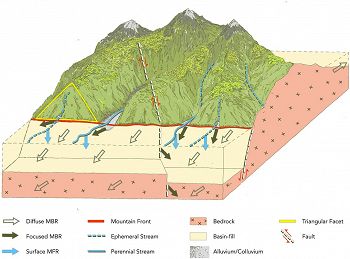Markovich et al., 2019
Mountain‐Block Recharge: A Review of Current Understanding
Markovich K.H, Manning A.H., Condon L.E., McIntosh J.C. (2019)
Water Resources Research 55(11): 8278-8304
-
Catalina-Jemez, INVESTIGATOR
Abstract
Conceptual diagram showing two mountain fronts: a sedimentary contact (far side) between the mountain block and basin fill and a fault‐controlled contact (near side). Different components of mountain‐front recharge (MFR) and mountain‐block recharge (MBR) are also shown, including surface MFR or infiltration through the basin fill from a mountain‐sourced perennial or ephemeral stream; focused MBR, which occurs either through discrete faults and fracture zones or underneath mountain‐sourced streams; and diffuse MBR, which occurs widely across the mountain front.
Mountain‐block recharge (MBR) is the subsurface inflow of groundwater to lowland aquifers from adjacent mountains. MBR can be a major component of recharge but remains difficult to characterize and quantify due to limited hydrogeologic, climatic, and other data in the mountain block and at the mountain front. The number of MBR‐related studies has increased dramatically in the 15 years since the last review of the topic was conducted by Wilson and Guan (2004), generating important advancements. We review this recent body of literature, summarize current understanding of factors controlling MBR, and provide recommendations for future research priorities. Prior to 2004, most MBR studies were performed in the southwestern United States. Since then, numerous studies have detected and quantified MBR in basins around the world, typically estimating MBR to be 5–50% of basin‐fill aquifer recharge. Theoretical studies using generic numerical modeling domains have revealed fundamental hydrogeologic and topographic controls on the amount of MBR and where it originates within the mountain block. Several mountain‐focused hydrogeologic studies have confirmed the widespread existence of mountain bedrock aquifers hosting considerable groundwater flow and, in some cases, identified the occurrence of interbasin flow leaving headwater catchments in the subsurface—both of which are required for MBR to occur. Future MBR research should focus on the collection of high‐priority data (e.g., subsurface data near the mountain front and within the mountain block) and the development of sophisticated coupled models calibrated to multiple data types to best constrain MBR and predict how it may change in response to climate warming.
Citation
Markovich K.H, Manning A.H., Condon L.E., McIntosh J.C. (2019): Mountain‐Block Recharge: A Review of Current Understanding. Water Resources Research 55(11): 8278-8304. DOI: 10.1029/2019WR025676
 This Paper/Book acknowledges NSF CZO grant support.
This Paper/Book acknowledges NSF CZO grant support.
Explore Further


